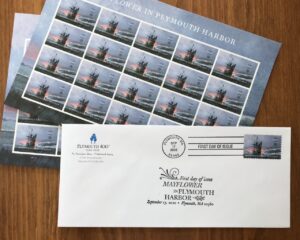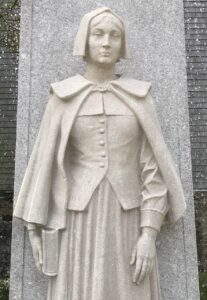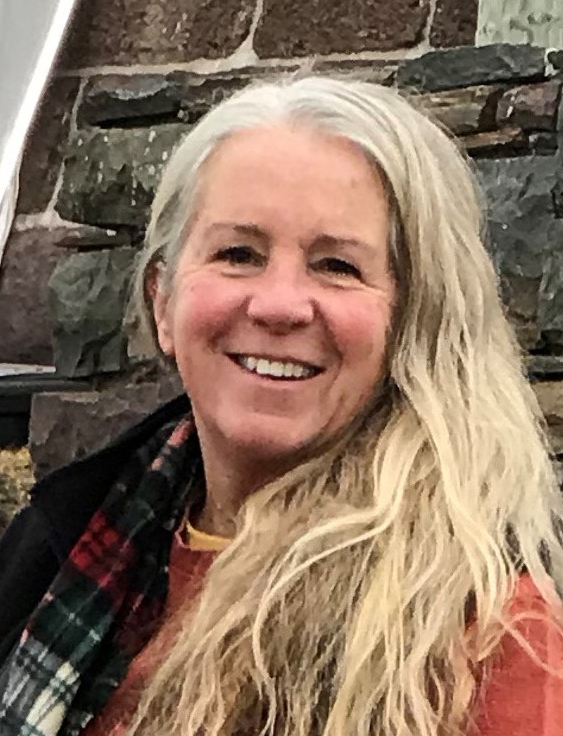 Proof that fears and concerns still prevail six months after the country was plunged into lockdown, isolation and quarantine could be found in the empty streets of Plymouth on the day that eager Mayflower descendants and philatelists should have been lining up for the first day issue of the long-awaited Mayflower in Plymouth Harbor stamp. All the empty parking spaces along the main thoroughfares were the first clue that the event, like so many others, had been scratched from calendars. But not mine.
Proof that fears and concerns still prevail six months after the country was plunged into lockdown, isolation and quarantine could be found in the empty streets of Plymouth on the day that eager Mayflower descendants and philatelists should have been lining up for the first day issue of the long-awaited Mayflower in Plymouth Harbor stamp. All the empty parking spaces along the main thoroughfares were the first clue that the event, like so many others, had been scratched from calendars. But not mine.
I slipped into an empty spot on Main Street in front of the Post Office and walked into the building, where I purchased two sheets of stamps to go along with the ten sheets I had pre-ordered online from the United States Post Office. In my optimism that the Plymouth post office would be inundated, I had pre-ordered just in case they sold out before I reached the window. I’m one of those people who still pays most bills by check and my plan is to use my Mayflower stamps throughout next year, 2021, in my own way honoring what will be a significant year of firsts in Mayflower and Pilgrim history.
Yes, surviving the grueling ten-week Atlantic crossing and finding refuge first in Provincetown Harbor and then in Plymouth Harbor in December 1620 is a momentous event deserving of recognition, but 1621 – the First Year – is the reason why, arguably, the Pilgrims are cemented in the American consciousness. Had the passengers not survived that first Winter of Death, not signed the treaty with Massasoit, not planted the first crops, not celebrated the first wedding, and not gathered with their Wampanoag friends for an autumn harvest feast, would the First Landing have been as significant a date on the calendar?
With stamps and envelopes in hand, I took my place in line, behind two other patrons, and received my first day issue cachets. The man in front of me had upward of thirty pieces to be cancelled and when it was my turn, I commented to the postmistress that she had had a good workout with that previous batch. “We had hoped for so much more,” she said wistfully. Hadn’t we all.
“We had hoped for so much more,” she said wistfully. Hadn’t we all.
Over the years, Plymouth has done a wonderful job turning its waterfront – with its signage, commemorative markers, and public art – into a cultural landscape and outdoor classroom, and it has become a kind of saving grace during this year when so much remains closed. Combined with follow-up information or further study that one can access on the iPhone, there is little excuse, even though most programming has been cancelled, not to salvage the significance and meaning of the Mayflower story.
Having been among the throngs of spectators cheering on the Mayflower II in August as it made its way through the Cape Cod Canal and back to Plymouth after its multi-year restoration in Mystic, Connecticut, I was eager to see it in all its glory berthed at the State Pier. Magnificent, indeed, it is open to visitors and I, along with four others, had it to ourselves. Staff members were available to answer questions and the lack of crowds meant time and space to reflect on what the Mayflower passengers endured during their harrowing journey – and to savor the beauty and intricacies of vessel herself. (She still had that new varnish smell!)
I ventured to ask of the guide how, since the original Mayflower had not survived more than a few years after returning to England in 1621, architects had been able to build the full-scale replica in 1957. Mayflower was typical of seventeenth-century merchant vessels – it had previously carried woolens and wine – and there are blueprints, still in existence, that describe those merchant vessels in detail. Another clue that assisted architects in building Mayflower II is a reference in Bradford’s Of Plimoth Plantation to the hiring of a vessel having a burden of “9 score,”[1] meaning its cargo capacity was 180 tuns, a tun being an English unit of liquid volume equal to about 252 wine gallons. Thus, in constructing Mayflower II, architects worked from the bottom up.
*
Disembarking from Mayflower II, I spied a small group at the Plymouth Rock pavilion who were enjoying a tour with a Pilgrim-garbed guide. A display panel adjacent to the pavilion offers an interesting timeline beginning with the 1741 “identification” of Plymouth Rock as the Pilgrim landing site, and continuing to December 1820, when, during the Pilgrim bicentennial, lawyer, statesman, and orator Daniel Webster reminded the citizens of Massachusetts of their storied past with a soaring two-hour speech that tied the Plymouth Rock legend to America’s destiny.[2]
In 1867, a Gothic Revival-style granite canopy was constructed over the rock, but not until 1880 were the two pieces of the rock, broken in 1774, reunited. For the tercentenary in 1921, a majestic portico, designed by the preeminent architects McKim, Mead & White (est. 1879), was installed over the rock in a new, reconfigured waterfront park. Interestingly, in his 1820 speech, Webster had imagined the next generation, one hundred years hence, surveying the progress of the country from the very same spot.
 From the pavilion, I tagged along with the walking tour group for a few stops, the next being the elegant Pilgrim Mother fountain, initiated in 1920 by the Daughters of the American Revolution as a tercentenary gift and dedicated in 1925. Conserved and restored for the four hundredth anniversary, the fountain was due to be rededicated on November 14, but that rededication has now been rescheduled for next year. Pilgrim Mother honors the eighteen married Mayflower women, three of whom were pregnant during the voyage, and fourteen of whom died before the first spring. Their names are inscribed on the monument. The fountain is the vision of Carl Paul Jennewein, born in Germany in 1890. At seventeen, he arrived in the United States and was apprenticed to the architectural sculptor Buhler and Lauter, a New York City firm often used by McKim, Mead & White, whose work Jennewein had known and admired as a teenager in Germany.
From the pavilion, I tagged along with the walking tour group for a few stops, the next being the elegant Pilgrim Mother fountain, initiated in 1920 by the Daughters of the American Revolution as a tercentenary gift and dedicated in 1925. Conserved and restored for the four hundredth anniversary, the fountain was due to be rededicated on November 14, but that rededication has now been rescheduled for next year. Pilgrim Mother honors the eighteen married Mayflower women, three of whom were pregnant during the voyage, and fourteen of whom died before the first spring. Their names are inscribed on the monument. The fountain is the vision of Carl Paul Jennewein, born in Germany in 1890. At seventeen, he arrived in the United States and was apprenticed to the architectural sculptor Buhler and Lauter, a New York City firm often used by McKim, Mead & White, whose work Jennewein had known and admired as a teenager in Germany.
From the Pilgrim Mother, we made our way up Cole’s Hill, rising steeply from Water Street and with a panoramic view of Plymouth Harbor. Adjacent to Leyden (First) Street, where the original Pilgrim houses were built, Cole’s Hill was used as a burial ground during the first winter, when more than half of the Mayflower passengers died. A marble sarcophagus atop Cole’s Hill, installed by the General Society of Mayflower Descendants in 1920, holds the remains of Pilgrims who had been secretly buried under the cover of dark and whose forgotten graves were unearthed over the decades during storms and excavations.[3]
...Cole’s Hill is dominated by the majestic nine-foot bronze statue of the Wampanoag sachem Massasoit, modeled by sculptor Cyrus E. Dallin.
Compelling as the sarcophagus is, Cole’s Hill is dominated by the majestic nine-foot bronze statue of the Wampanoag sachem Massasoit, modeled by sculptor Cyrus E. Dallin (1861-1944). Commissioned as “a grateful tribute” by the Improved Order of Red Men,[4] Dallin began submitting models for the project in 1911, having recently completed a four-piece equestrian series, The Epic of the Indian.[5] His Native American sculptures conveyed the humanity and dignity of the indigenous people with whom he had spent his childhood in Utah, then on the American frontier. When the statue of Massasoit was unveiled during the Pilgrim tercentenary, Charlotte Mitchell (1848-1930), known as Princess Wootonekanuske, a descendant of Massasoit, was an honored guest.
Today, at the foot of Cole’s Hill and across Water Street, another Cyrus Dallin statue pays tribute to Gov. William Bradford, who was among those Pilgrim leaders to negotiate a treaty with Massasoit, forging political and personal ties for the next fifty years. The Bradford statue, though modeled in plaster for the tercentenary, was not cast until the 1976 American Bicentennial. Reproduced by sculptor Adio diBiccari (1914-2009), the statue was dedicated on Thanksgiving Day 1976. Born in Revere, Massachusetts to Italian immigrant parents, diBiccari is best known for his bronze figures representing Religion, Industry and Learning on Boston Common’s Parkman Plaza. After the Second World War, he settled in Arlington, Massachusetts, where Cyrus Dallin had also made his home in 1900.[6]
*
The last stop on my Plymouth peregrination was the Mayflower Society House, with its grand view of the harbor and the Mayflower II. Originally four rooms built in 1754, it was the home of Edward Winslow (1714-1784), the son of Isaac Winslow and the great-grandson of Mayflower passenger Edward Winslow. A staunch Loyalist during the Revolutionary War, Winslow’s property was confiscated and he and his family fled to Halifax, Nova Scotia, where he is buried.
The Winslow house changed hands several times over the years before being purchased in 1898 by business tycoon Charles Willoughby, who, with Plymouth-born architect Joseph Everett Chandler (1863-1946), transformed the simple colonial home into one of Plymouth’s finest mansions, the estate we see today. Behind the house, Chandler designed a Colonial Revival garden that played host to many a garden party during the Willoughby era. In 1941, the Winslow home was purchased from the Willoughby family by the General Society of Mayflower Descendants.
Though the house is closed, the peaceful garden is open for respite and contemplation, the bricks of its walkway honoring the Pilgrim families, a tangible testament to their fortitude and survival and their continuing place in the American consciousness.
Continued here.
Notes
[1] A score is 20, thus nine times twenty equals 180.
[2] Daniel Webster’s speech, “First Settlement of New England,” was delivered to the Pilgrim Society at Plymouth’s First Church, with more than 1,200 in attendance. It was considered soul-stirring, electrifying, and, in the words of Harvard scholar George Ticknor, “burning eloquence.” The full text can be found at Archive.org, The great speeches and orations of Daniel Webster, 1886.
[3] The Pilgrim remains were originally installed in a chamber in the 1867 Plymouth Rock canopy.
[4] The Improved Order of Red Men, one of America’s oldest fraternal organizations, is descended from the Sons of Liberty, members of which disguised themselves as Native Americans and orchestrated the Boston Tea Party. The rituals and structure of the Red Men are modeled on presumed Native American terminology.
[5] The last and most famous of the series, Appeal to the Great Spirit (1908), graces the plaza entrance to the Museum of Fine Arts in Boston.
[6] Cyrus Dallin made yet another contribution to the Pilgrim tercentenary, commemorating the Signing of the Mayflower Compact with his magnificent 9-by-16-foot bas relief at the base of High Pole Hill in Provincetown. He was also consulted by the tercentenary commission regarding the rejoining and “patching” of Plymouth Rock, said to have then been in three pieces after being removed from the waterfront in preparation for the new portico.
Share this:

About Amy Whorf McGuiggan
Amy Whorf McGuiggan recently published Finding Emma: My Search For the Family My Grandfather Never Knew; she is also the author of My Provincetown: Memories of a Cape Cod Childhood; Christmas in New England; and Take Me Out to the Ball Game: The Story of the Sensational Baseball Song. Past projects have included curating, researching, and writing the exhibition Forgotten Port: Provincetown’s Whaling Heritage (for the Pilgrim Monument and Provincetown Museum) and Albert Edel: Moments in Time, Pictures of Place (for the Provincetown Art Association and Museum).View all posts by Amy Whorf McGuiggan →